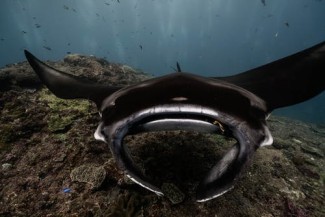
The Sea Devil by Arthur Gordon is a tale of a life-changing encounter that a man has while going fishing one hot September night in Florida. This story is based on the classic theme of man vs. nature. The man in the story hasn’t been expecting the sudden accident which nearly ends his life. This tale warns that one should never underestimate the unpredictability of nature and that one should always be prepared for the worst. The narrative makes use of detailed descriptions to paint a vivid picture of how the story unfolds. This tale brilliantly captures the overwhelming power of nature and man’s innate instinct to survive.
The Sea Devil | Summary
“The Sea Devil” is a story about a life-changing experience of a man while he ventures out in the sea. One hot September night in Florida, an unnamed man in his late twenties goes outside his house and throws away his cigarette while staring at the ocean. He enjoys the solitude and elemental atmosphere of the beach at night. He observes some mullets splashing around in the dark water and decides to go fishing.
He doesn’t have to fish for a living and he doesn’t have a lot of experience but he loves the thrill that comes with it. It is far more exciting than his boring life; he enjoys being the hunter while he’s fishing. The night is dark and “black as a witches’ cat”. It is difficult to see anything clearly but he loves the stillness and isolation of the ocean at night and doesn’t want to miss this opportunity.
He takes a net and gets on a skiff, which he uses for fishing. He ties the net around his wrist with a slipknot and throws it over the water. He manages to catch a mullet and then moves towards the old dock to catch more. The old dock is marked by two stakes half-submerged in water. He observes two ripples in water and thinks he’s about to catch multiple preys however by mistake he catches a gigantic manta ray in his net and thus he gets dragged underwater.
He chokes on the water as he struggles to free himself from the net tied to his wrist. Unable to free himself, he wrestles like a fish thrashing around fighting for his life. He tries to get hold of one of the stakes from the old dock but the stake is coated with razor-sharp barnacles and he ends up cutting his hand. He thinks this is going to end his life soon as images flash before him: his wife, the cigarette he threw away, and the mullet he caught. As death approaches, he becomes less afraid and makes one last attempt to survive. He desperately wraps the rope of the net around one of the old stakes and it enables him to break free from the net as the barnacles cut the net rope. He gets on his skiff and throws the mullet back into the water. He decides he’ll never go fishing in the darkness of night again.
The Sea Devil | Analysis
The Sea Devil is told in the third person narrative where the narrator details an incident that nearly killed a man. The main conflict is the man struggling to fight off the giant fish. The protagonist of the story is the man and he is the only human character in the story. The story is set near a mangrove beach in Florida. The story reveals how man is merely one of the many creatures that Nature holds within its grasp. The man in the story ventures out to experience what nature has to offer and views it as something that can be tamed, perhaps something out of which he might derive some pleasure. He seems to enjoy the idea of being the “hunter” in the vast open ocean and takes a small boat to catch some fish. It is important to note that he doesn’t have to fish for a living. His decision to explore the sea to catch some fish stem not out of necessity but out of sheer pleasure. However, Nature has something else in store for him entirely.
It catches him by surprise when he’s least expecting it. The manta ray that his nets end up catching is much stronger than him and begins dragging him underwater. The “hunter” becomes the hunted. The net that he uses to catch the fish ends up entangling him and he becomes the very thing that he sought to catch. The narrator describes him as struggling like a fish thrashing around and fighting for his life. This use of this simile is symbolic. The fact that his struggle is likened to that of a fish reveals an important aspect in the story – Nature doesn’t discriminate in its treatment towards the fellow creatures whose fate it shapes. For Nature, the man and the ray are one. The man is the fish that he sets out to catch and the manta ray he has ended up catching. In the eyes of Nature, the fish, the man, and the ray are the same.
An important point to note in this story is that while the man seems to view the ray as an enemy, – viewing it as a sea “devil”, it really is just another life form struggling to survive. For him, the manta ray is a “monster” or a “devil” that almost killed him. Nature doesn’t have anything personal against the man. It is merely running its course. The impersonal, disinterested aspect of Nature is revealed in this story.
The man shows intellect, determination, courage and patience. The man was in his late twenties and thus fairly strong in build but it was his intellect that saved him. He mostly uses his physical strength as he struggled to break free from the net but it is “only by using his brains” he survived. While he was breathless underwater, he calculated that he could still survive for a few more seconds and this encouraged him to keep fighting. He “called on his brain for a solution” and it gave him the idea to cut the rope. He wrapped the rope of the net around the stake with barnacles which enable him to set himself free. Even after multiple failed attempts to escape he did not give up, he kept fighting for survival. There was a possibility the stake barnacles could cut him to pieces but he still took a chance and finally won.
The man changed his perspective at the end of the story, at the beginning of the story he used to enjoy fishing at night and took pleasure in the feeling of being a hunter. Then suddenly he found himself experiencing how his prey must have felt when he trapped them. He finally understood their struggle to survive and that’s why once he was back on the skiff he threw the mullet he caught back into the water.
The Sea Devil | Themes
Man vs. Nature
The manta ray’s untamed and brutal moves represent nature while the man’s willpower and quick-witted actions represent humans. There has always been a struggle between mankind and nature as both compete for dominance over each other. In this story, the man survived but he met nature’s dangerous side which shook him up and changed his perception. At first, the ocean appeared still and safe to the man while he was standing on the beach then suddenly there was a chaotic turn of events. Fishing used to be entertaining for the man while he forgot the cruel act he was committing against the aquatic life. After tasting the fear of slow death he changed and became more humble.
That being said the man in the story isn’t a cold-hearted person because we learn that when once on the Gulf he caught a baby porpoise along with the Captain and after he saw the mother porpoise try to save her child, “he felt sorry for her and made the captain let the baby porpoise go”. He wasn’t killing for pleasure but he was still blind-sighted to the prey’s suffering and thus nature taught him a lesson that he’ll never forget.
Survival
Ultimately the man survives the battle against the manta ray. It shows human persistence to keep fighting for life. The man almost gave up and accepted death but he didn’t lose all hope and kept fighting, he used his brain to find a solution. It’s an innate quality of man to find ways to survive. The story warns us about the dangers of nature but also shows that there’s hope for survival.
The Sea Devil | About the author
Born in Savannah, Georgia Arthur G. Gordon (1912-2002) was an American scholar, editor, and writer. He graduated from Yale University and served with the Air force during World War II. His famous works include “Reprisal”, “A Touch of Wonder”, “Target Germany,”, and his biography of Norman Vincent Peale “One Man’s Way”. “Reprisal” and “One Man’s Way” were adopted on-screen in 1956 and 1964 respectively.


